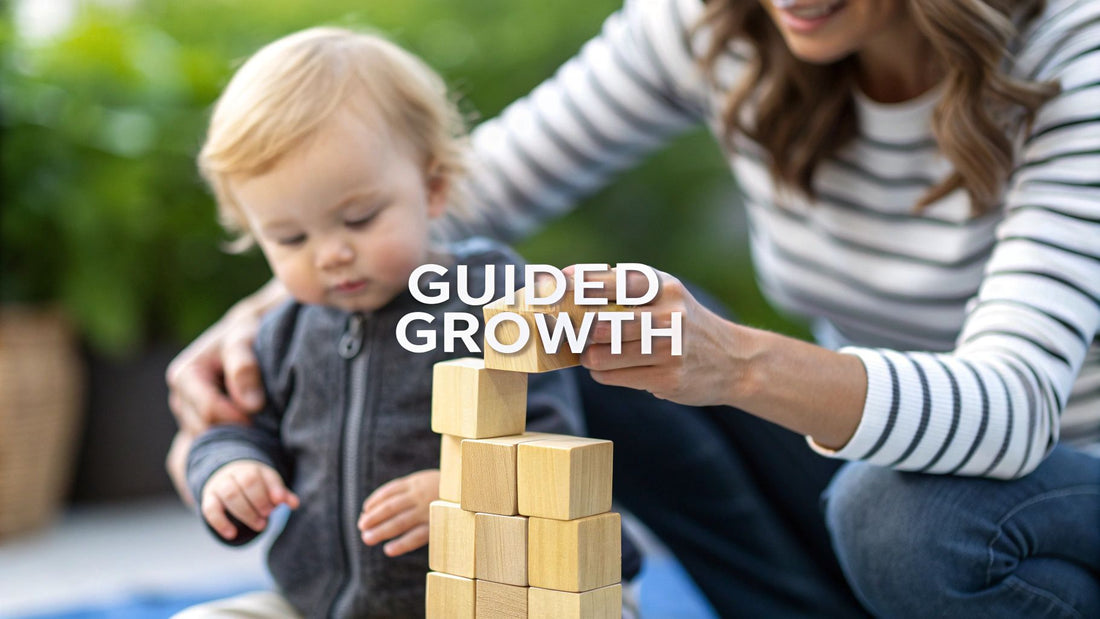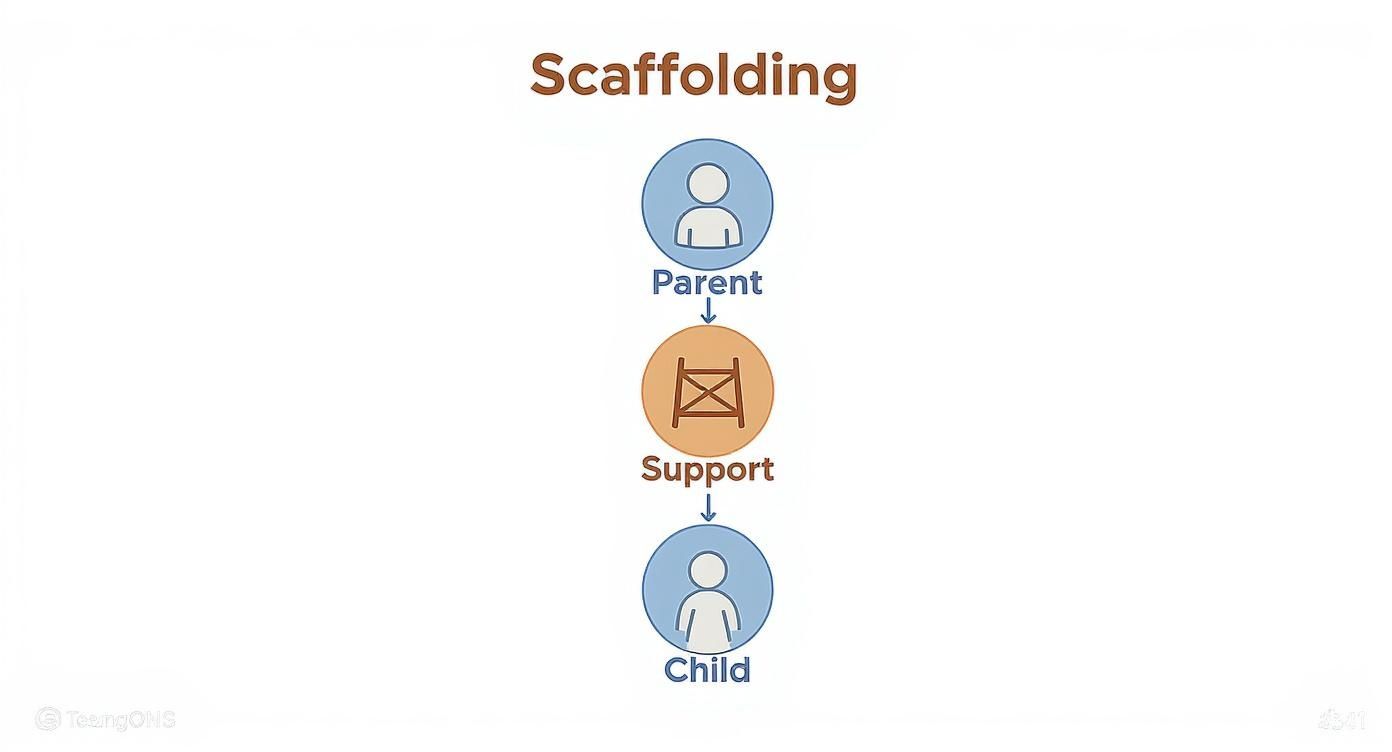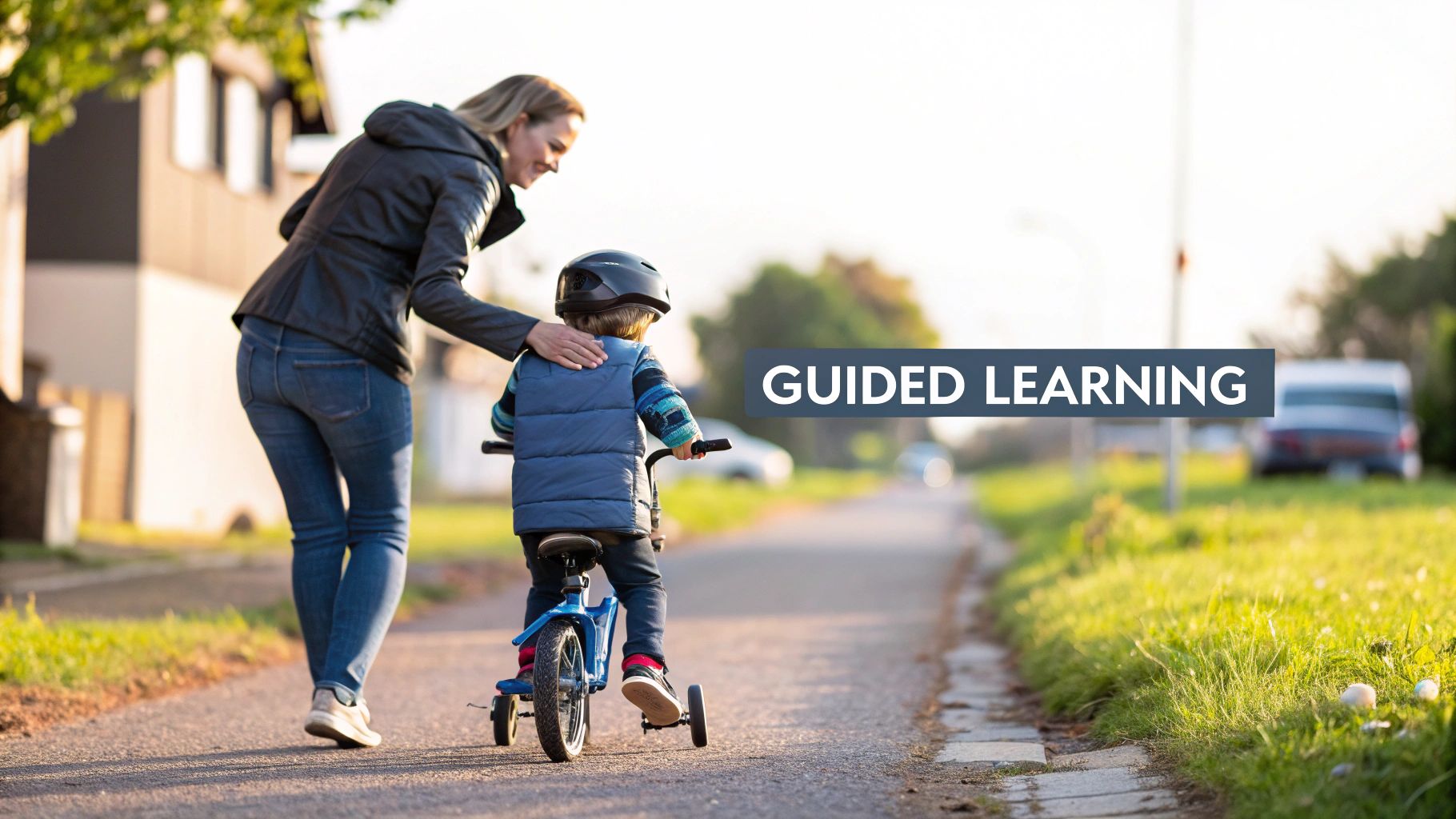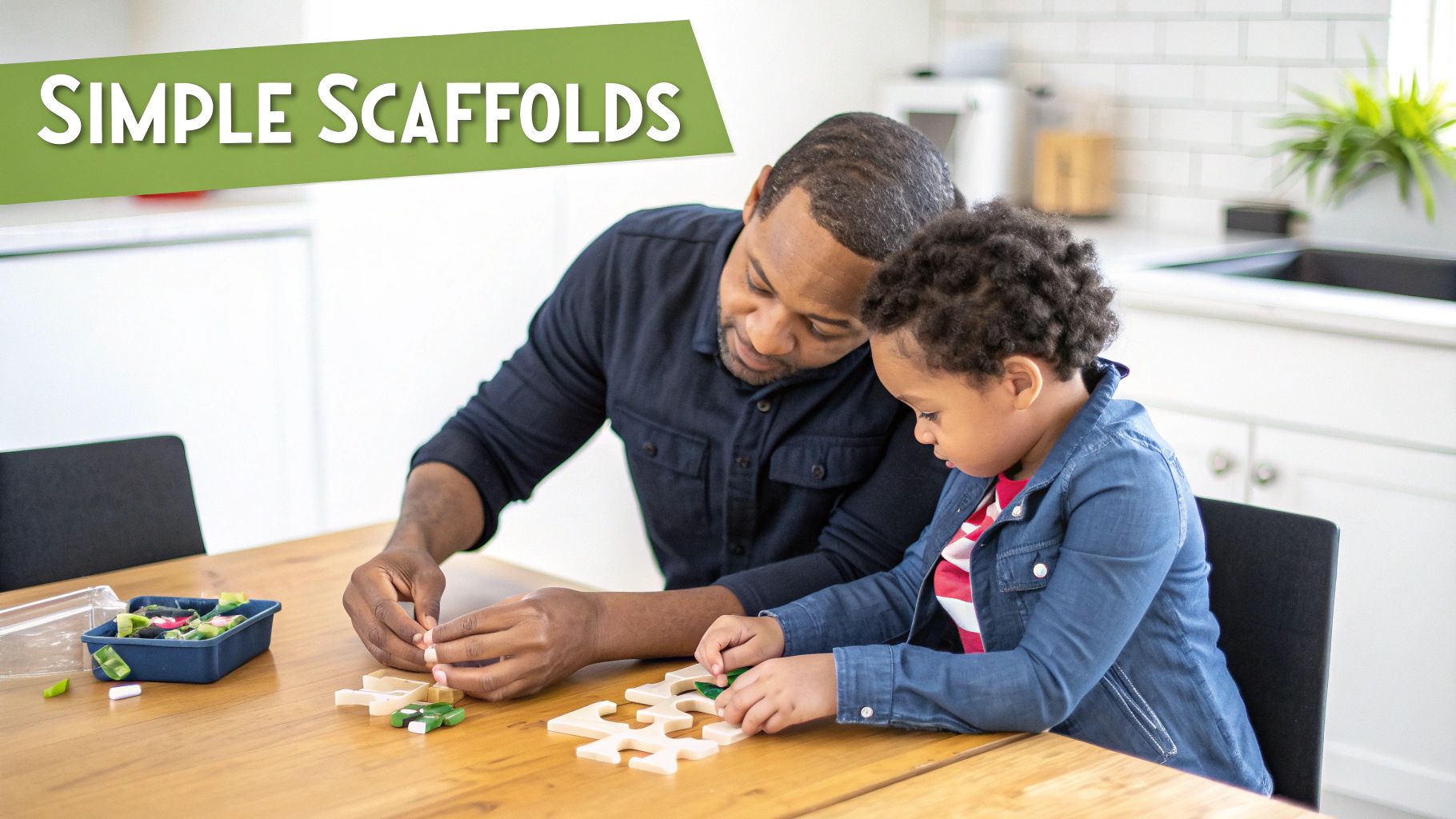
What Is Scaffolding In Child Development For Parents
Share
At its core, scaffolding in child development is all about giving your child just enough help to tackle a task they can't quite manage on their own. Think of it like holding the back of a bicycle—you’re there to offer stability while they figure out how to pedal, but you let go the second they find their balance.
Breaking Down The Scaffolding Theory
Let's say your little one is struggling with a puzzle that's a bit too tricky. Instead of just solving it for them, you might nudge a corner piece closer or ask, "Where do you see a piece with this blue color?" That supportive little prompt is the essence of scaffolding. It’s not about handing over the answers; it's about giving them the clues and tools to build their own understanding.
This idea was brought into the spotlight by psychologist Lev Vygotsky and his concept of the "Zone of Proximal Development" (ZPD). Don't let the fancy name fool you. The ZPD is simply that sweet spot for learning—the magical space between what a child can already do alone and what they can achieve with a bit of guidance. Scaffolding is the bridge that helps them get from one side to the other.
This diagram shows how it works: you, the caregiver, provide a temporary structure (the scaffold) that lets your child reach new heights they couldn't get to before.

Ultimately, the goal isn't to create dependency. It's to build their confidence and competence so they can eventually master the skill all by themselves.
The Goal of Guided Support
The whole process relies on providing tailored help that you slowly pull back as your child gets the hang of things. This works so well because it keeps kids engaged in tasks that are challenging but not totally overwhelming—the perfect conditions for growth.
This temporary support can look like a lot of different things:
- Modeling a task so they can see how it's done first.
- Breaking a big project into smaller, more manageable steps.
- Asking open-ended questions to get their little gears turning.
- Offering encouragement to build up their confidence and resilience.
This approach lines up beautifully with many educational philosophies, including principles you can use at home when you're looking into Montessori education at home. Understanding the power of guided support is also highlighted by the numerous benefits of early intervention for child development. When support is offered and then carefully removed, it fosters incredible independence and problem-solving skills down the road.
The Core Principles Of Effective Scaffolding

Great scaffolding is more of an art than a science. It’s built on a few core ideas that turn simple “helping” into something much more powerful. To really get what scaffolding is in child development, we have to look past just lending a hand. It's about being an intuitive guide who knows precisely when to step in, how much to do, and—most importantly—when to step back.
These principles all work together, building your child's confidence right alongside their skills. Once you get the hang of them, you can transform everyday moments into huge learning opportunities that empower your child to tackle challenges all on their own.
Contingent Support: Just Enough Help
The first big idea is contingent support. This just means giving help that’s directly tied to what your child needs in that exact moment. It’s about offering the smallest bit of assistance they need to get over a specific hurdle, without you taking over the whole task.
Picture your toddler trying to stack blocks, but the tower keeps tumbling down. Instead of rebuilding it for them, you might just steady the bottom block with one finger. That tiny, well-timed intervention gives them the stability they need to figure out the next step themselves.
This responsive approach is everything. You aren't following a script; you're reacting in real-time to their struggles and successes, making sure your support is always spot-on.
Fading: The Graceful Step Back
Once your child starts getting the hang of a new skill, the next principle kicks in: fading. This is simply the gradual removal of your support as their competence grows. Think of it like slowly letting go of the back of the bike seat as your child starts to find their balance.
The process should feel subtle and encouraging. If you were helping your child learn to zip up their jacket, fading might look like this:
- Week 1: You do the entire zipper for them.
- Week 2: You guide their hand as they pull the zipper up.
- Week 3: You only help them connect the two sides at the bottom.
- Week 4: You just watch and cheer them on as they do it all by themselves.
Fading isn't about leaving your child to struggle; it's about showing them you have confidence in their growing abilities. This gradual retreat empowers them to take ownership and builds their self-esteem, proving you trust them to succeed on their own.
Transfer Of Responsibility: The Ultimate Goal
The final, and most important, principle is the transfer of responsibility. This is the whole point of scaffolding—that moment when your child fully masters the skill and doesn't need your help anymore. They’ve gone from being a guided learner to the independent owner of a new ability.
This transfer is what happens when contingent support and fading are done right. It’s the moment your child zips their jacket without a second thought, ties their shoes without being asked, or finishes a puzzle all by themselves.
They haven't just learned a task; they've learned how to learn. They’ve built problem-solving skills, persistence, and the confidence to take on the next challenge, knowing they have what it takes to figure it out. This is where scaffolding truly shapes a resilient, capable little person.
How Scaffolding Shapes Confident and Resilient Kids
The real magic of scaffolding isn't just about teaching your kid to tie a shoe or finish a puzzle. It goes so much deeper. This supportive way of helping actually shapes their inner world, building not just skills, but solid character. It's one of the best ways to raise a capable, emotionally secure child.
When you scaffold a task, you're sending a powerful message: "This is tricky, but I know you can figure it out." This completely changes how they see challenges. A tough task stops being a scary wall they might fail to climb and becomes a solvable problem instead. That mindset is the absolute bedrock of true resilience.
By guiding them through a problem instead of just handing them the answer, you're literally helping their brain build pathways for critical thinking. They learn to look at a situation, try out different solutions, and push through the frustration—all while knowing you're right there if they get truly stuck.
Fostering Independence and Self-Esteem
Every single time a child figures something out with your help, they get a huge hit of accomplishment. This isn't the cheap satisfaction of being given a solution; it's the deep, lasting confidence that comes from doing it themselves, with just the right nudge from you.
This process is a direct line to nurturing their independence. They learn they don't need someone to do things for them because they're perfectly capable of learning how to do things themselves. This core belief in their own abilities is what fuels healthy self-esteem and makes them brave enough to tackle bigger and harder things down the road.
Scaffolding teaches children that effort, not just being "good at something," is what leads to success. This fosters a growth mindset, where they see their skills as things they can build over time, not as fixed traits.
Strengthening The Parent-Child Bond
Scaffolding is also a huge relationship-builder. These little moments of teamwork are built on trust and patience, showing your child that you’re a reliable partner on their learning adventure. This collaborative vibe strengthens your connection in a few key ways:
- It builds trust: Your child learns they can count on you for help without you taking over or getting frustrated.
- It creates positive memories: Working together to solve a problem becomes a happy, shared experience you both remember.
- It encourages communication: You end up naturally talking through the problem, which models healthy communication skills without you even trying.
Think of each interaction as a small deposit into your relationship bank. It turns moments that could be full of frustration into opportunities for teamwork and respect, building an emotional security that’s just as important as any skill they'll ever learn.
Scaffolding Techniques You Can Use Today
Knowing the theory is one thing, but understanding what scaffolding is in child development really comes alive when you put it into practice. The best part? You're probably already using some of these techniques without even realizing it. Now you can start applying them more intentionally.
From the toddler years right through to elementary school, the core idea is the same—you just change your tools. It’s all about watching your child, figuring out exactly where they get stuck, and offering just enough of a nudge to help them push forward on their own.
Scaffolding For Toddlers And Preschoolers
For our littlest learners, scaffolding is often very physical and verbal. Their entire world is about mastering their bodies and figuring out simple cause-and-effect. Your support should be direct, simple, and full of encouragement.
Cleanup time is a perfect example. Instead of the vague command, "Clean up your toys," you can scaffold the task into tiny, achievable steps:
- Model the behavior: Start by picking up one block and saying, "I'm putting the red block in the bin."
- Give simple, one-step directions: "Can you put the blue block in the bin now?"
- Offer physical help: If they struggle, you can gently guide their hand with the block toward the basket.
- Use specific praise: "Great job! You put the block away all by yourself!"
This same strategy works wonders for getting dressed, learning to use a fork, or washing hands. Many parents find that using safe, child-sized furniture, like a learning tower, creates a natural physical scaffold. It brings them right up to counter height, removing a major barrier so you can focus on scaffolding the actual skill, like stirring batter or washing vegetables. You can see more great examples of how everyday tasks build independence by exploring these Montessori practical life activities.
Scaffolding For School-Aged Children
As kids get older, their challenges become more cognitive and social. Your scaffolding will naturally shift from physical guidance to more language-based support. You'll be helping them break down complex ideas and navigate tricky social situations. Homework is a classic battleground where this is needed.
Instead of just giving them the answer to a tough math problem, try scaffolding their thinking process:
- Ask guiding questions: "What's the very first step the instructions mention?" or "What do we already know about this kind of problem?"
- Help them organize: Break a big project into smaller, more manageable chunks with their own mini-deadlines.
- Talk through frustration: When they get stuck, try saying, "It's totally okay to feel frustrated. Let's take a quick break and look at it with fresh eyes in a few minutes."
Scaffolding isn't about making sure your child never struggles. It’s about teaching them how to struggle productively, building their resilience and problem-solving skills for the long haul.
This approach is just as powerful for social issues. If your child is upset after a spat with a friend, you can help them process it by asking, "How do you think they were feeling when that happened?" or "What's one thing you could try saying next time?" You're not solving their problems for them, but you're giving them the tools to understand and resolve conflicts on their own in the future.
Scaffolding Techniques By Developmental Stage
To make this even clearer, let's look at how scaffolding changes as your child grows. The goal is always the same—to provide temporary support—but the way you provide that support evolves.
| Developmental Stage | Example Activity | Scaffolding Technique |
|---|---|---|
| Toddler (1-3 years) | Building a simple block tower | "Let's put the big red block on the bottom first." (Modeling and verbal cues) |
| Preschooler (3-5 years) | Learning to write their name | Providing a worksheet with their name dotted for them to trace. |
| School-Aged (6+ years) | Completing a book report | Helping them create an outline with sections for characters, plot, and conclusion. |
As you can see, the support becomes less direct over time. You slowly fade into the background, letting your child take on more and more of the task independently. That's the real magic of scaffolding.
Scaffolding Your Child's Emotional Growth

Scaffolding isn’t just for puzzles and building blocks; it’s one of the most powerful tools you have for nurturing your child’s emotional intelligence. Think about it—just like you support them when they're learning to walk, you can guide them through the messy, confusing world of feelings. This kind of support builds a rock-solid foundation for resilience, empathy, and strong relationships down the road.
At its core, emotional scaffolding is all about helping kids recognize, name, and manage their feelings in a healthy way. When a big emotion like frustration or sadness takes over, a young child simply doesn't have the words or skills to process what’s happening. Your job is to be the temporary support system they need to get through those overwhelming moments.
Naming and Validating Big Feelings
One of the simplest yet most profound ways to scaffold emotions is to help your child put a label on what they're feeling. It’s a game-changer. Imagine your toddler's block tower comes crashing down, and they immediately dissolve into tears.
Instead of the classic, "Don't cry," try stepping in with gentle guidance. You could say, "You worked so hard on that tower, and it fell. I can see you’re feeling frustrated and sad." This does two amazing things: it hands them the vocabulary for their experience, and it validates that their feeling is real and perfectly okay.
By putting a name to a big, scary emotion, you make it feel more manageable for your child. It's the first step toward teaching them that feelings are signals, not something to be afraid of. This validation builds emotional security and trust.
Over time, this approach helps children develop incredible self-regulation skills. They start to identify their feelings on their own, which is the crucial first step toward managing their reactions in a healthy way.
Using Stories and Modeling Behavior
Stories are a fantastic way to scaffold social and emotional learning. Cuddling up with a book gives you a safe space to talk about tricky situations like sharing, disappointment, or kindness. For some great conversation starters, you can explore our list of books to read to kindergartners.
Modeling is another huge piece of the puzzle. Your kids are always watching how you handle your own emotions. When you calmly express your feelings—"I’m feeling a little stressed because we're running late"—you're showing them how to manage emotions without getting swept away.
To go even deeper, look for resources that boost their understanding of self and emotions. By consistently using these scaffolding techniques, you aren't just getting through a tantrum. You're building a resilient, empathetic, and emotionally intelligent person, one feeling at a time.
Common Questions About Scaffolding

Once you start seeing how powerful scaffolding can be, it's totally normal for some practical questions to come up. Understanding the theory is one thing, but putting it into practice in the messy, wonderful reality of daily parenting is another beast entirely.
Let’s dig into some of the most common concerns. Getting these sorted will help you feel much more confident in your approach.
Am I Helping Too Much?
One of the biggest worries we hear from parents is about the fine line between supportive scaffolding and unhelpful "helicopter parenting." It's a valid concern—how do you help without accidentally taking over?
The key difference really comes down to your goal. Over-parenting aims to prevent failure at all costs, often by doing the task for the child. Scaffolding, on the other hand, is all about empowering your child to succeed on their own by providing just enough support to get them through a sticking point.
So, how can you tell the difference? Ask yourself this one simple question: "Is my help building their skills or just finishing the task?" If you're building skills, you're on the right track.
Here’s a quick gut-check to see if you might be giving too much assistance:
- You feel more invested than they do. If you find you're the one pushing an activity forward while your child has mentally checked out, it might be time to pull back.
- They aren't learning from mistakes. Mistakes are where the real learning happens. If your support prevents them from ever making one, you're removing a vital part of the process.
- They immediately look to you for the answer. If your child’s first instinct is to ask for help rather than trying first, you may need to fade your support more intentionally.
True scaffolding fosters independence. If your support seems to be creating more dependency over time, it's a sign to re-evaluate and gently step back. Give them a little more room to problem-solve on their own.
When Is The Right Time To Start Scaffolding?
The wonderful thing about scaffolding is that it’s not something you suddenly have to "start" at a certain age. You can begin from day one. In fact, you probably already are! Scaffolding naturally evolves as your child grows, adapting to meet their changing developmental needs.
For an infant, scaffolding might be as simple as holding a toy just within their reach to encourage them to grasp it. For a toddler, it's guiding their hand as they learn to use a spoon. The principles stay the same; only the context changes.
The best time to jump in with a scaffolding technique is whenever your child is in their Zone of Proximal Development—that sweet spot where a task is too hard to do alone but totally achievable with your help. This means being a good observer, watching for those moments of productive struggle where a little support can make all the difference.
What If My Child Still Gets Frustrated?
Let's be real: frustration is a completely normal—and even necessary—part of learning. The goal of scaffolding isn't to eliminate frustration but to keep it from boiling over into a full-blown meltdown. When your child hits a wall and gets upset despite your help, see it as a signal to adjust your approach, not to give up.
First, validate their feelings. Saying something like, "I know, this puzzle is really tricky. It's okay to feel frustrated," shows them they’re seen and understood.
Then, try one of these little adjustments:
- Break it down even smaller. Make the very next step so tiny that it feels almost impossible to fail.
- Offer a different kind of support. If verbal cues aren't working, try modeling the action instead.
- Take a collaborative break. Suggest working on it together for a minute or just taking a short break to reset and come back fresh.
Remember, the goal is to keep the experience positive and build resilience. Teaching them how to handle frustration is one of the most valuable skills you can possibly scaffold.
At Ocodile, we design furniture that creates the perfect environment for this kind of supportive learning. Our standing towers and child-safe step stools act as a physical scaffold, bringing your child to the right height to participate in kitchen activities safely and confidently. This allows you to focus on scaffolding the skill itself, turning everyday moments into opportunities for connection and growth. Explore our collection at https://ocodile.com and see how our thoughtful designs can support your family's journey.








